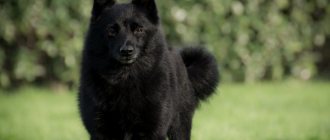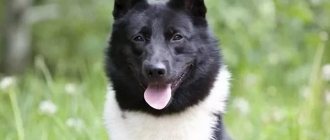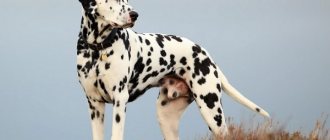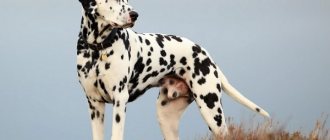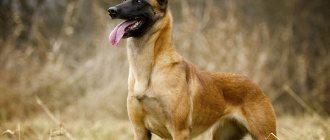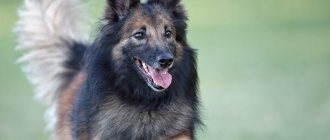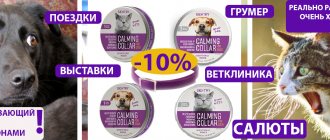The Schipperke is considered the smallest shepherd dog bred in the Flemish region of Belgium to hunt mice and rats. In Europe the breed is called "Schipperke". These animals combine a perky disposition, a great thirst for life and boundless loyalty to their owner. The breed is not so common in our country, so before getting such a pet, you need to study its features and disadvantages.
Description of the Schipperke dog breed includes many positive features
History of the breed
Some dog breeders mistakenly assume that the Schipperke's closest relatives are Spitz. However, the dogs owe their origin to Belgian Shepherds and Leuvenards - extinct individuals who lived in the 15th century in the province of Brabant.
The Schipperke gained its popularity in the 17th century, and all thanks to its excellent ability to catch mice. Dogs were also held in high esteem by Brussels artisans and sailors.
The first participation in exhibitions took place in 1882, after which Queen Henrietta Maria showed interest in pets and bought a puppy. All the local nobility followed her example.
Puppies penetrated abroad only in 1887. In 1888, a fan club was opened and the breed received its standard.
In Russia, only in 2000 did they start breeding puppies.
Application
Schipperke (Flemish - small shepherd dog) at the beginning of the formation of the breed was used as a hunter of small rodents, which besieged the homes and grocery stores of medieval Europeans in huge numbers.
Nowadays there is no such need, and Belgians can increasingly be seen in families as companions, as well as in exhibitions and shows.
Description of the breed
A cute, cute dog with a triple layer of fur. Under the thick skin hides a well-proportioned, muscular body.
The average height of pets varies from 25 to 33 cm, weight – up to 9 kg.
Important! The female and the male differ from each other in proportions and dimensions.
The breed is not prone to excessive aggression
Links[edit]
- ^ab Dr. Robert Pollet. "Schipperke...what's in a name?" . www.schipperke.be
. Archived from the original on October 9, 2014. Retrieved March 22, 2022. - Jump up
↑ Schipperke Club, Club Flyer AKC, September 2008 - "Individual Results of the Pedigree Dog Health Study".
- Skipperke club, s. 2
- University of Pennsylvania, School of Veterinary Medicine, Mucopolysaccharidosis IIB (MPS IIIB), 2008.
- University of Pennsylvania, School of Veterinary Medicine, “New DNA Test for Inherited Diseases in Schipperkes.” The Bellwether 56: September. 2003, pp. 7, 9.
- Schipperke Health Survey. Orthopedic foundation for animals. offa.org
- American Kennel Club, Skipperke History, AKC, 2013.
- "meet... Schipperke". Continental Kennel Club
. Retrieved March 22, 2022. - Coile Carolina (December 21, 2015). "Meet Schipperke: The Little Captain!" . Dogster
. Retrieved March 22, 2022.
Advantages and disadvantages
Before buying a four-legged pet, you need to take into account the characteristic pros and cons of the breed.
Pros:
- suitable for keeping both in an apartment and on the territory of a private house;
- excellent guard qualities;
- absolute fearlessness;
- devotion to the owner and members of his family;
- wonderful intellect.
Minuses:
- high cost of puppies;
- need for long and active walking.
Important! The Schipperke is a dog that always becomes a true friend and reliable protector.
She gets along well with small children.
The dog needs constant walking in unknown places
Price
As mentioned earlier, the breed is extremely difficult to find in Russia. The price of a Schipperke starts from 50 thousand rubles - and this is the cheapest option in the pet class. Dogs of this class are not suitable for breeding and do not participate in competitions, but they will be loyal friends and protectors.
Show-class puppies are ideal for competitions and cost from 80 thousand rubles. But those who want to breed the breed professionally must pay 100-120 thousand rubles for a bitch. It is better to purchase Schipperkes from qualified breeders or abroad. There dogs of this breed cost from 1300 US dollars.
Breed standard
The description of the Schipperke breed depends on its origin. At exhibitions, those from the United States are of greatest value, but formally the American and European branches are considered equal.
A puppy that is purchased for further participation in exhibitions must meet the conformation requirements
Head
The dimensions are proportional, the shape is wedge-shaped, visually shortened. The forehead is rounded and wide.
Jaws and teeth
A scissor bite is ideal, but pets with a straight bow are not considered defective. The teeth are white and strong. A complete set of teeth is desirable, but missing first and second premolars and third molars are not abnormal.
Nose
The nose is neat, the nose is black.
Eyes
It is preferable that animals do not have protruding or deep-set eyes. The eyelids are black, the eye shape is almond-shaped.
Ears
The ears are in the shape of a triangle, small in size.
Neck
The neck is set high, strong, and somewhat curved in the upper part.
Frame
The short body resembles a square shape, but the silhouette is light. The back and lower back are set straight, and slightly raised between the withers and croup.
Limbs
The limbs are parallel to each other, the shoulder blades are long, the elbows are strong, and the pasterns are short.
Tail
A puppy may be born with a long tail, a short tail, or no tail at all. A full tail has a standard length.
Tail docking is strictly prohibited.
Wool
The coat is straight and thick, consisting of a coarse, abundant axle and a soft undercoat.
Color
Only black undercoat is officially recognized, but grayish is also allowed if it is not visually obvious. Rare are dogs with golden, cream, chocolate and black and tan colors. Only representatives of the breed with black coat color are allowed to participate in exhibitions.
Disqualifying faults
Disqualifying defects are malocclusion, ears that are not shaped according to the standard, as well as those with soft and excessively long hair. The reason to limit participation in exhibitions is the presence of an animal with depigmented lobes, weight that does not correspond to the norm, as well as the absence of four teeth.
Owner reviews
Albina
I always wanted to have a service dog, but a small apartment is not the best place for a large dog, so I chose a Schipperke, who turned out to be an excellent companion. The shepherd dog, originally from Belgium, is remarkably trainable and becomes a true friend for its owner.
Egor
Our four-legged pet is very affectionate, but only shows his friendliness to members of our family. Strangers arouse suspicion and wariness in him, which makes the Schipperke a good watchman and security guard. I think that this breed has some disadvantages: the dog’s desire to participate in all the activities that the owner is involved in.
Schipperke character
The Schipperke is a great friend for the whole family. The dog is inquisitive; it is important for him to know about everything that is happening around his household. Left alone with himself, the four-legged pet begins to languish with melancholy, so it is better not to leave him alone for a long time.
He cannot sit in one place for a long time, so he needs regular and long walks, where he can throw out the accumulated energy.
Despite their modest size, these individuals are true protectors who know no fear. They notify about approaching danger by barking loudly, and if it has not passed, they are ready to rush at the offender.
The Schipperke is an excellent watchman and mouse catcher.
Kinds
The Schipperke is not divided into subspecies within the breed, but breeders have conditional differences for dogs. If she lives indoors, her fur thins out significantly. It does not lose its beauty, but becomes less dense and the undercoat disappears. Animals living in an enclosure fluff up, grow undercoat, and because of this they appear stockier and larger.
The coat is always thick and dense. The guard hair is straight, hard, coarse, but the undercoat is soft and fluffy. The fur on the ears and face is much softer than the rest of the hair. The fur on the dog's chest forms a beautiful shirtfront. There are also dense areas of wool around the tail, which creates the “pants”.
The color of the Schipperke is only black, although some breeders also recognize a chocolate tint. Sometimes a black dog may appear red, but this effect is due to the undercoat being faded or falling out. In old age, the dog turns grey, so light hairs appear abundantly throughout the body.
Schipperkes are smart dogs and highly trainable.
Education and training
It is necessary to raise a dog as soon as it crosses the threshold of a new home. Already at the age of 2 months, the puppy is completely ready to comprehend the wisdom of training.
Pets cannot focus on one type of activity for a long time, so the activity should last no more than 5 minutes, after which the dog needs to have a short rest. A peculiarity of the breed is its love for praise, expressed in the offered treat - this is convenient, because in this way you can stimulate the dog to carry out the desired command.
Important! Training should only be done by an adult, since the child’s commands will simply be ignored by the four-legged friend due to non-recognition of the latter’s superiority.
Your pet should be trained from puppyhood
Interesting Facts
The name of the breed is translated from Belgian as “baby boatman”. This shows how important the Schipperke were for sailing ships - after all, they effectively destroyed rats that interfered with the lives of sailors and ate their food.
There is a version that in one of the dialects of the Belgian language the name of the breed is translated as “tiny shepherd dog”. This version has a place to be, because Schipperkes are really shepherd dogs. Sometimes dogs were called little black devils because the cute dogs killed rats with particular cruelty.
Schipperkes mature only at the age of five. For some dogs, by this time half of their life has already passed, but for representatives of the breed, life is just beginning. Pets sincerely love children, including small ones. Dogs are best suited for children aged seven years and older, because they play together for a long time and tirelessly.
Hygiene
Caring for your dog must be done in compliance with the following mandatory procedures:
- Brush the dog's fur once a week, and during the shedding period - 2-3 times a week.
- You should bathe no more than 2 times a year. You can also remove dirt from wool with dry shampoo. After each walk, wipe the paws with a damp cloth.
- The ears are cleaned once a week using cotton pads.
- Nails are trimmed as they grow.
Hygiene affects the dog's physical health.
Excerpt characterizing Schipperke
- Well, are you bored here? asked Pierre. - It’s not boring, falcon. Call me Plato; Karataev’s nickname,” he added, apparently in order to make it easier for Pierre to address him. - They called him Falcon in the service. How not to be bored, falcon! Moscow, she is the mother of cities. How not to get bored looking at this. Yes, the worm gnaws at the cabbage, but before that you disappear: that’s what the old men used to say,” he added quickly. - How, how did you say that? asked Pierre. - Is that me? – asked Karataev. “I say: not by our mind, but by God’s judgment,” he said, thinking that he was repeating what had been said. And he immediately continued: “How come you, master, have estates?” And there is a house? Therefore, the cup is full! And is there a hostess? Are your old parents still alive? - he asked, and although Pierre could not see in the darkness, he felt that the soldier’s lips were wrinkled with a restrained smile of affection while he was asking this. He was apparently upset that Pierre did not have parents, especially a mother. “A wife is for advice, a mother-in-law is for greetings, and nothing is dearer than your own mother!” - he said. - Well, are there any children? – he continued to ask. Pierre's negative answer again apparently upset him, and he hastened to add: “Well, there will be young people, God willing.” If only I could live in the council... “It doesn’t matter now,” Pierre said involuntarily. “Eh, you’re a dear man,” Plato objected. - Never give up money or prison. “He sat down better and cleared his throat, apparently preparing for a long story. “So, my dear friend, I was still living at home,” he began. “Our patrimony is rich, there is a lot of land, the men live well, and our home, thank God.” The priest himself went out to mow. We lived well. They were real Christians. It happened... - And Platon Karataev told a long story about how he went to someone else’s grove behind the forest and was caught by a guard, how he was whipped, tried and handed over to the soldiers. “Well, the falcon,” he said, his voice changing with a smile, “they thought grief, but joy!” My brother should go, if it were not for my sin. And the younger brother has five boys himself - and look, I have only one soldier left. There was a girl, and God took care of her even before she became a soldier. I came on leave, I’ll tell you. I see they live better than before. The yard is full of bellies, women are at home, two brothers are at work. Only Mikhailo, the youngest, is at home. Father says: “All children are equal to me: no matter what finger you bite, everything hurts. If only Plato hadn’t been shaved then, Mikhail would have gone.” He called us all - believe me - he put us in front of the image. Mikhailo, he says, come here, bow at his feet, and you, woman, bow, and your grandchildren bow. Got it? speaks. So, my dear friend. Rock is looking for his head. And we judge everything: sometimes it’s not good, sometimes it’s not okay. Our happiness, my friend, is like water in delirium: if you pull it, it swells, but if you pull it out, there’s nothing. So that. - And Plato sat down on his straw. After being silent for some time, Plato stood up. - Well, I have tea, do you want to sleep? - he said and quickly began to cross himself, saying: “Lord, Jesus Christ, St. Nicholas, Frol and Lavra, Lord Jesus Christ, St. Nicholas!” Frol and Lavra, Lord Jesus Christ - have mercy and save us! - he concluded, bowed to the ground, stood up and, sighing, sat down on his straw. - That's it. “Put it down, God, like a pebble, lift it up like a ball,” he said and lay down, pulling on his greatcoat. -What prayer were you reading? – asked Pierre. - Ass? - said Plato (he was already falling asleep). - Read what? I prayed to God. Don’t you ever pray? “No, and I pray,” said Pierre. - But what did you say: Frol and Lavra? “But what about,” Plato quickly answered, “a horse festival.” And we must feel sorry for the livestock,” Karataev said. - Look, the rogue has curled up. She got warm, the son of a bitch,” he said, feeling the dog at his feet, and, turning around again, immediately fell asleep. Outside, crying and screams could be heard somewhere in the distance, and fire could be seen through the cracks of the booth; but in the booth it was quiet and dark. Pierre did not sleep for a long time and, with open eyes, lay in his place in the darkness, listening to the measured snoring of Plato, who lay next to him, and felt that the previously destroyed world was now being erected in his soul with new beauty, on some new and unshakable foundations. In the booth into which Pierre entered and in which he stayed for four weeks, there were twenty-three captured soldiers, three officers and two officials. All of them then appeared to Pierre as if in a fog, but Platon Karataev remained forever in Pierre’s soul as the strongest and dearest memory and personification of everything Russian, kind and round. When the next day, at dawn, Pierre saw his neighbor, the first impression of something round was completely confirmed: the whole figure of Plato in his French overcoat belted with a rope, in a cap and bast shoes, was round, his head was completely round, his back, chest, shoulders, even the hands that he carried, as if always about to hug something, were round; a pleasant smile and large brown gentle eyes were round.
Walking, physical activity and rules of safe behavior on the street
The dog is walked 2 times a day, and the duration of one walk should be at least 1 hour. Walks should be varied; you need to regularly change the place for them.
Walking should only be done on a leash, since the dog is often carried away by extraneous sounds and can run away from the owner in order to study their source.
Walking - only on a leash
Health [edit]
Picture of a Schipperke puppy at 12 weeks of age
Schipperke has no particular health problems. According to a UK Kennel Club survey, the average lifespan of the breed is 13 years, with about 20% living to 15 years or more. Of the 36 dogs in the survey that died, the oldest dog was 17 1 ⁄ 2 years old. [3] However, inactivity, lack of exercise and overeating are very harmful and can lead to joint and skeletal problems, as well as dental, heart, lung or digestive problems. Schipperke's main orthopedic problem is patellar dislocation and Legg-Perthes syndrome. Some Schipperks have shown a tendency towards epilepsy, although there is no test: it appears to be due to genetic transmission. [4]
The only caveat to the good health of the Schipperke is MPS IIIB, a genetic mutation that occurs in a maximum of 15% of the general breed population. This only happens with Schipperkes. The University of Pennsylvania School of Veterinary Medicine developed a test for the disease and began accepting samples in April 2003. [5] Clinical signs appear between two and four years, and there is no known treatment or cure. The disease affects balance, coordination of obstacles (such as stairs), and is similar to such lysosomal storage diseases in humans as Tay-Sachs disease and Gaucher disease. [6] The Schipperke is also susceptible to some other physical problems, as reported by Orthopedic Foundation for Animals. [7]
Features of feeding and diet
When a puppy appears in the house, the owner needs to create a diet and diet, since if the Schipperke is not fed correctly, the dog will lose its shape. Nutrition can be provided with both natural and industrial food, but only the dog product must be super-premium class.
With natural food, it is necessary to choose exclusively fresh products: lean meats, cereals, vegetables, fruits.
As for the regime, it is composed as follows:
- up to 2 months – 6 times a day;
- from 2 to 4 months – 5 times a day;
- from 4 to 6 months – 4 times a day;
- from 6 to 8 months – 3 times a day;
- from 9 months – 2 times, morning and evening.
Feeding
The type of food is chosen by the owners. High-quality dry food contains balanced vitamins and minerals. The advantage of natural food is that it suits the digestion of any individual, but cooking takes time, and the addition of mineral complexes is also necessary.
The menu is updated:
- Lean meat.
- Fish fillet.
- By-products.
- Porridge.
- Vegetable supplements.
Milk porridge is prepared for the little ones, and boiling water is poured over the cereal for adults. Feed with boiled eggs and raw yolks, fermented milk products. Babies are fed more often, and from the age of nine months they are transferred to morning and evening feeding.
How to choose a puppy
When choosing a puppy you must:
- contact the nursery directly;
- find out whether the female and the male were tested for the presence of hereditary diseases - you can find out more on the RKF website;
- pay attention to the general appearance of the puppies - they should be well-fed, neat and active;
- palpate the tail of natural length for kinks and thickenings.
The cost of a puppy is very high and it is better to purchase it from a nursery
Mating
The bitch is ready for reproduction already with the appearance of her first heat, at 8-9 months of age. But dogs should not be bred earlier than 2 years of age: by this moment, all the organs of the bitch are fully formed, and she is fully ready to bear offspring.
The female and male dogs must be tested for genetic diseases before being allowed to breed. The bitch must have all her vaccinations according to schedule. Only in this case will Schipperke puppies be guaranteed to be protected from many canine infectious diseases (distemper, rabies, enteritis).
For mating, the bitch arrives at the dog's territory. Schipperkes are knitted by themselves, without human help. After 24-48 hours, a control mating is carried out to consolidate the result.
